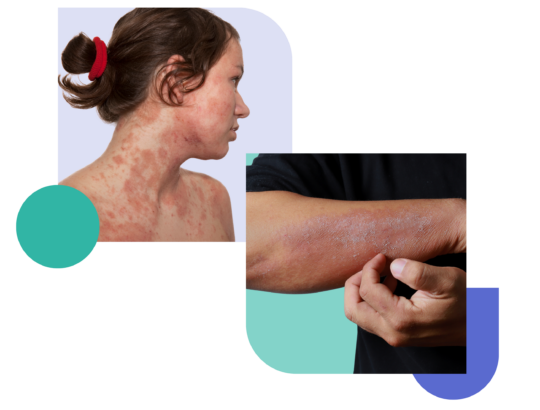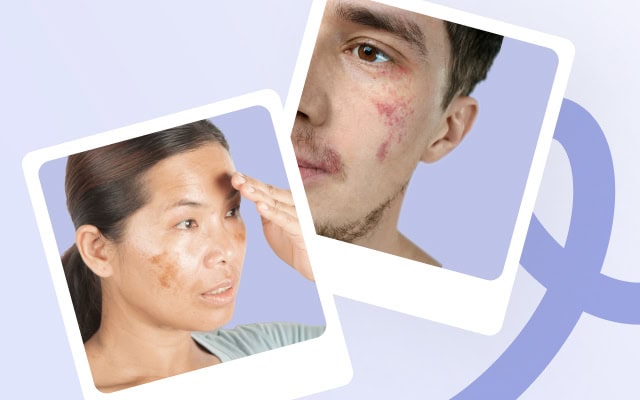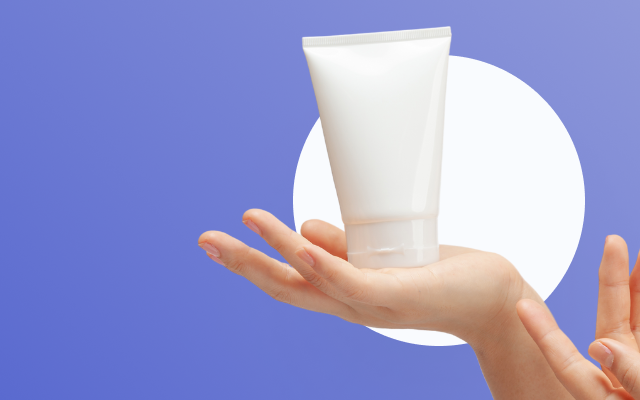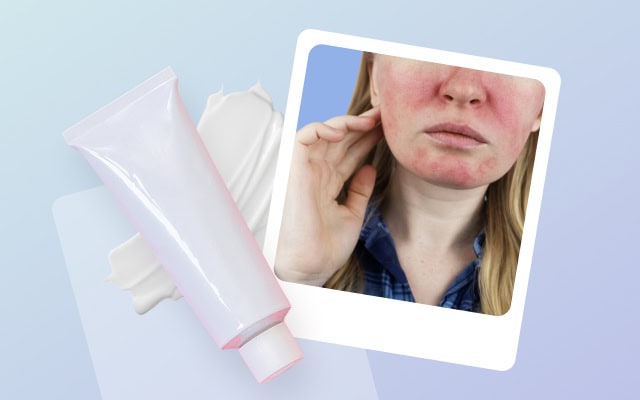How to get a (pompholyx) dyshidrotic eczema treatment cream?
Dr. Carolina Fernandez, board-certified dermatologist, talks about the different dyshidrotic over the counter and prescription-strength creams and tells you how to get them.
Table of Content:
What is dyshidrotic eczema? | Is it chronic? | How to get a prescription? | Best treatment creams for dyshidrotic eczema | Over the counter creams for dyshidrotic eczema | Pills and injections for dyshidrotic eczema | About dyshidrotic eczema | FAQ
Our commitment to producing high-quality content:
The information presented in this article is based on scientific research and the professional advice of our Content Medical Reviewers, who are experts in the field of Dermatology. How we write our content →
What is dyshidrotic eczema?
Dyshidrotic eczema, also known as dyshidrosis or pompholyx, is a type of eczema that causes small, itchy blisters on the edges of the fingers, toes, palms of the hands, and soles of the feet. These blisters are often filled with fluid and can be quite uncomfortable.
Often, pompholyx shows a clear seasonal predominance in the warmer spring and summer months, so it has long been assumed to be related to a chronic sweating disorder with periods of flare-ups and remission.
However, with proper management, symptoms can be controlled and the frequency and severity of flare-ups can be reduced1.
Is dyshidrotic eczema a chronic condition?
Dr. Carolina Fernandez, board-certified dermatologist, says that dyshidrotic eczema is often a chronic condition, meaning it tends to come and go over time, often in cycles of flare-ups and remissions. While some people may experience only a few episodes in their lifetime, others deal with recurrent or persistent flares, especially if underlying triggers aren’t identified or managed.
How to treat dyshidrotic eczema?
Dr. Carolina Fernandez, board-certified dermatologist, says that since it is a chronic condition, it is best to seek professional guidance from a board-certified dermatologist since the beginning. They will help you with the long-term management of your condition and assist when your have flares. You can consult an independent, board-certified dermatologist in your state via Miiskin.
How to get a prescription for a dyshidrotic eczema treatment cream?
You can have a photo-consultation with a board-certified dermatologist via Miiskin. First-time consultation is $59 and prescription renewals are only $39. Once the dermatologist issues your prescription, you can buy it at a local pharmacy.
Secure, confidential, and reviewed by board-certified dermatologists.
What are the best treatment creams for dyshidrotic eczema?
Dr. Fernandez says that some of the most common treatment creams for dyshidrotic eczema are topical corticosteroid creams as they reduce inflammation and itchiness quickly, topical calcineurin inhibitors, and potassium permanganate soak.
Corticosteroid creams and ointments
Topical corticosteroid creams are only used to control acute flare-ups of dyshidrotic eczema and reduce inflammation and itching quickly. Once the flare-up is under control, the frequency of application is usually reduced, and maintenance treatments are implemented to prevent recurrence.
These topical creams and ointments come in different strengths ranging from low to very high potency. Your online dermatologist will assess the severity of your condition and will prescribe a treatment cream that has the right strength for you.
- Clobetasol propionate 0.05% (very potent)
- Betamethasone dipropionate 0.05%
- Triamcinolone acetonide 0.1% (medium strength)
Topical calcineurin inhibitors
Topical calcineurin inhibitors like tacrolimus (Protopic) and pimecrolimus (Elidel) do not contain steroids, making them suitable for long-term use without the risk of steroid-related side effects.
These topical treatments reduce inflammation by inhibiting the activity of calcineurin, a protein involved in activating the immune response. This helps control the itching and redness associated with dyshidrotic eczema. Besides, calcineurin inhibitors do not cause skin thinning, making them a safer option for delicate skin areas.2
- Tacrolimus 0.1% or 0.03% ointment
- Pimecrolimus 1% cream
Potassium permanganate soak
Potassium permanganate, often used in the form of Permitabs, is sometimes employed in the treatment of dyshidrotic eczema. It works as an antiseptic and astringent, helping to dry out the blisters and reduce the risk of secondary infection. Patients typically dissolve Permitabs in water to create a dilute solution, which is then used for soaking the affected areas. This treatment can help alleviate symptoms and promote healing by reducing inflammation and preventing bacterial growth. However, it should only be used under the guidance of a dermatologist to ensure safety and effectiveness.3
Are there any over-the-counter creams or ointments for dyshidrotic eczema?
Yes, there are several over-the-counter (OTC) creams that can help manage the symptoms of mild dyshidrotic eczema. While these may not be as effective as prescription medications, they can provide relief, to some extent.
- Vaseline: Provides a barrier that locks in moisture and protects the skin.
- Thick creams: Products like CeraVe, Eucerin, Aquaphor, and Aveeno are effective at moisturizing and protecting the skin.
- Ointments: These are thicker than creams and can provide a longer-lasting barrier, for example, Aquaphor Healing Ointment4
- Dimethicone-based creams: These help form a barrier on the skin to protect it from irritants. Products like Cetaphil moisturizing cream contain dimethicone.
- Aloe vera gel: Known for its soothing properties, aloe vera can help reduce irritation.
- Calamine lotion: Provides soothing relief from itching.
- Oatmeal-based products: Aveeno offers a range of products containing colloidal oatmeal, which can help soothe and protect the skin.
Are there oral medications (pills) or injections for dyshidrotic eczema?
Oral antihistamines
You can use a wide variety of over the counter and prescription-strength antihistamines to control itching, especially if the itching is severe.5
Oral steroids
In severe cases, your dermatologist may prescribe short courses of oral corticosteroids to combat flare-ups.6
Immunosuppressants
In chronic and severe cases, your doctor may prescribe methotrexate tablets (Rheumatrex), mychophenolate tablets (CellCept) or dupilumab injections (Dupixent).7
Alitretinoin (Toctino)
Alitretinoin (known commercially as Toctino) is an oral retinoid used for the treatment of severe chronic hand eczema (including pompholyx) that has not responded to treatment with potent topical steroids. Alitretinoin works by reducing the inflammation associated with eczema as well as damping down the response of the immune system.8
Intradermal Botox injections
Intradermal injection of onabotulinumtoxinA (Botox) has been explored as a treatment for dyshidrotic eczema, particularly for cases resistant to conventional therapies. This treatment involves injecting small amounts of Botox directly into the affected skin areas to reduce sweating, which can be a trigger for eczema flare-ups. By decreasing sweat production, Botox can help reduce moisture-related triggers and inflammation, potentially alleviating symptoms like itching and blistering. Studies have shown promising results, but this treatment should be administered by a qualified healthcare professional and is typically considered when other treatments have not been effective.9
Secure, confidential, and reviewed by board-certified dermatologists.
About dyshidrotic eczema (pompholyx)
Is dyshidrotic eczema the same as dyshidrosis?
Yes, dyshidrotic eczema, pompholyx and dyshidrosis refer to the same condition. These terms describe a type of eczema characterized by the appearance of small, fluid-filled blisters on the palms of the hands, sides of the fingers, and soles of the feet.
Dyshidrotic eczema causes
Although the exact cause of dyshidrotic eczema is not fully understood, it is believed to be triggered by stress, allergies, moist hands and feet, and exposure to certain metals like nickel or cobalt. There also may be a genetic component to it, as it sometimes runs in families.10
How do I know if I have dyshidrotic eczema?
To determine if you have dyshidrosis (dyshidrotic eczema), you should look for the symptoms that are characteristic from this condition and try some over-the-counter creams. If your condition does not improve, or gets worse, you should consider seeking a professional diagnosis from a board-certified dermatologist via Miiskin.
Dyshidrotic eczema symptoms
Blisters
- Small, fluid-filled blisters appear on the edges of fingers, toes, palms, and soles.
- The blisters are typically very itchy and may cause a burning sensation.
Itching and pain
- Intense itching often precedes the appearance of blisters.
- The blisters can be painful, especially if they become large or burst.
Redness and swelling
- Affected areas may become red and swollen.
- Surrounding skin may appear inflamed.
Skin changes
- After the blisters dry up, the skin may become scaly, cracked, or peel off.
- The skin might also thicken and develop deep cracks, particularly on the hands and feet.11
Dyshidrotic eczema triggers
- Irritants: Contact with certain metals (like nickel or cobalt), chemicals or detergents
- Stress: High stress levels can exacerbate symptoms
- Allergies: Known food allergies, hay fever or other atopic conditions
- Lack of moisture: Frequent hand washing or exposure to water12
What else can you do to get rid of dyshidrosis?
- Apply wet compresses: Applying wet dressings can soothe the skin, reduce itching, and prevent scratching.
- Ultraviolet light therapy (PUVA): Exposure to ultraviolet light can help reduce symptoms, particularly in severe or chronic cases.
- Avoid triggers: Identifying and avoiding known triggers such as certain metals (nickel, cobalt), and prolonged exposure to water or irritants.
- Wear protective gloves: Wearing gloves when doing housework, gardening, or when in contact with potential irritants.
- Stress management: Techniques such as mindfulness, meditation, or other stress-relief practices can help since stress can trigger or worsen symptoms.
- Dietary changes: Identifying and eliminating food allergens or irritants from the diet.
- Good Skincare Routine: Establishing and maintaining a regular skincare routine to keep the skin moisturized and protected.
- Self-care practices: Keeping the affected areas dry, avoiding excessive washing, and using mild, fragrance-free soaps.
- Use moisturizer: Use a moisturizer after washing your hands to protect your hands from excessive dryness13
What should I avoid if I have dyshidrotic eczema?
Dr. Fernandez says that if you have dyshidrosis (dyshidrotic eczema), there are several things you should avoid to help manage the condition and prevent flare-ups.
Nickel and cobalt
- Avoid jewelry, coins, and other items that contain nickel or cobalt
- Limit consumption of foods high in nickel and cobalt, such as nuts, seeds, chocolate, and certain green leafy vegetables.14
Prolonged exposure to water
- Take short showers or baths
- Wear gloves when washing dishes or handling water frequently
Avoid extreme temperatures
- Avoid extreme heat or cold, which can trigger symptoms
- Keep your living environment at a comfortable temperature
Identify and avoid allergenic foods
- Identify and avoid food allergens that may trigger symptoms, such as dairy, eggs, gluten, nuts, and shellfish
- Reduce intake of foods high in nickel, such as chocolate, soy products, lentils, and canned foods
- Limit foods high in cobalt, such as fish, shellfish, and certain leafy greens
Use mild skin care products
- Avoid harsh soaps, detergents, and cleaning products
- Use mild, fragrance-free soaps and cleansers
- Avoid products with alcohol, fragrances, or other harsh chemicals
- Use gentle, moisturizing products formulated for sensitive skin
Avoid tobacco and limit alcohol
- Avoid smoking and limit alcohol consumption, as they can aggravate skin conditions.
- Specific clothing and accessories
Avoid synthetic fabrics or poorly ventilated shoes
- Avoid wearing non-breathable, synthetic fabrics that can trap sweat and irritate the skin
- Choose loose, breathable clothing made from natural fibers like cotton.
- Avoid wearing tight or poorly ventilated shoes that can cause sweating and friction on the feet
Secure, confidential, and reviewed by board-certified dermatologists.
Frequently asked questions about dyshidrotic eczema
Is dyshidrotic eczema contagious?
Dr. Fernandez says that dyshidrotic eczema is not contagious. The condition involves “sympathetic reactions at a distance,” which means that inflammatory lesions can appear on parts of the skin that are similar in structure to the area of the infection. This often occurs in cases of athlete’s foot, where there is a significant inflammatory response. However, dyshidrotic eczema itself cannot be spread from person to person.
Is dyshidrotic eczema caused by stress?
Dr. Fernandez says that although stress is a significant trigger for dyshidrotic eczema, it is not the sole cause. This skin condition likely results from a combination of factors, including genetics, allergies, irritants, moisture, diet, infections, and seasonal changes. Stress can exacerbate symptoms by affecting the immune response, leading to the characteristic blisters and itching. To manage dyshidrotic eczema, it is important to reduce stress through techniques like meditation, yoga, and maintaining a healthy lifestyle. Additionally, addressing other triggers and working with a healthcare provider can help control and reduce flare-ups effectively.
Is dyshidrotic eczema dangerous?
Dr. Fernandez says that while uncomfortable and sometimes painful, dyshidrotic eczema is not considered dangerous. However, it can significantly impact quality of life due to its symptoms and potential complications such as:
- The blisters and cracked skin can become infected if bacteria enter through broken skin. Signs of infection include increased redness, warmth, pus, and swelling. In severe cases, an infection may require antibiotic treatment.
- Persistent itching and pain can interfere with daily activities, work, and sleep, leading to chronic discomfort and stress.
- Repeated flare-ups and scratching can lead to long-term skin changes, such as thickening (lichenification), scarring, or discoloration.
Can apple cider vinegar help with dyshidrosis?
Dr. Fernandez says that apple cider vinegar may offer some benefits for managing dyshidrotic eczema due to its antibacterial properties and ability to balance skin pH. However, it should be used with caution, always diluted, and not applied to open wounds. Consulting a healthcare provider before using vinegar treatments is recommended to ensure safety and effectiveness.
Can clotrimazole be used to treat dyshidrotic eczema?
Dr. Fernandez says that clotrimazole is not used for the treatment of dyshidrotic eczema, however, it can be used to treat secondary fungal infections that may occur alongside the condition. The proper diagnosis and consultation with a healthcare provider are essential to ensure the appropriate use of clotrimazole when you have dyshidrotic eczema.
Is there a permanent cure for dyshidrotic eczema?
Dr. Fernandez says that although dyshidrotic eczema is a chronic condition, many people find ways to manage their symptoms effectively and reduce the frequency and severity of flare-ups. Working closely with a dermatologist to develop a personalized treatment plan is crucial for managing the condition.
Does dyshidrotic eczema affect the hands or palms?
Dyshidrotic eczema frequently affects the hands, leading to blisters, itching, redness, and sometimes pain. Effective management involves a combination of treatments, protective measures, and avoiding known triggers to reduce symptoms and prevent flare-ups.
Does dyshidrotic eczema affect the soles of the feet or toes?
Yes, dyshidrotic eczema can affect the feet, typically manifesting as small, fluid-filled blisters on the soles and sides of the toes. These blisters can be intensely itchy and sometimes painful, leading to redness, swelling, and subsequent skin peeling and cracking. Effective management includes using topical treatments, keeping the feet dry, avoiding irritants, and wearing breathable footwear to reduce symptoms and prevent flare-ups.
Lee éste artículo en Español ¿Qué es la dishidrosis y cuál es el mejor tratamiento?
Provider & Prescription Information
Miiskin connects patients with independent dermatologists who provide care through their private practices. Compounded prescriptions can be ordered via Miiskin and are dispensed by Foothills pharmacy. Standard medications can be issued for any local pharmacy.
Article references:
1 https://nationaleczema.org/eczema/types-of-eczema/dyshidrotic-eczema/
2 https://www.aad.org/public/diseases/eczema/types/dyshidrotic-eczema/treatment
3 https://eczema.org/information-and-advice/types-of-eczema/pompholyx-eczema-2/
4 https://www.medicalnewstoday.com/articles/aquaphor-eczema
5 https://my.clevelandclinic.org/health/diseases/17728-dyshidrotic-eczema
6 https://www.aad.org/public/diseases/eczema/types/dyshidrotic-eczema/treatment
7 https://my.clevelandclinic.org/health/diseases/17728-dyshidrotic-eczema
8 https://eczema.org/information-and-advice/types-of-eczema/pompholyx-eczema-2/
9 https://pubmed.ncbi.nlm.nih.gov/11952288/
10 https://my.clevelandclinic.org/health/diseases/17728-dyshidrotic-eczema
11 https://my.clevelandclinic.org/health/diseases/17728-dyshidrotic-eczema
12 https://www.aad.org/public/diseases/eczema/types/dyshidrotic-eczema/treatment
13 https://my.clevelandclinic.org/health/diseases/17728-dyshidrotic-eczema
14 https://www.aad.org/public/diseases/eczema/types/dyshidrotic-eczema/treatment
Skin conditions and treatments
Articles written in collaboration with dermatologists
Facial treatment for seborrheic dermatitis
How to get rid of rosacea permanently?
How to calm a rosacea flare-up fast?
Spongiotic dermatitis: What is it and what is the best treatment?
A dermatologist’s guide to psoriasis medication






 Still dealing with eczema? Get expert help from home.
Still dealing with eczema? Get expert help from home.
